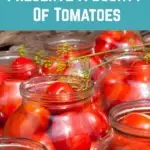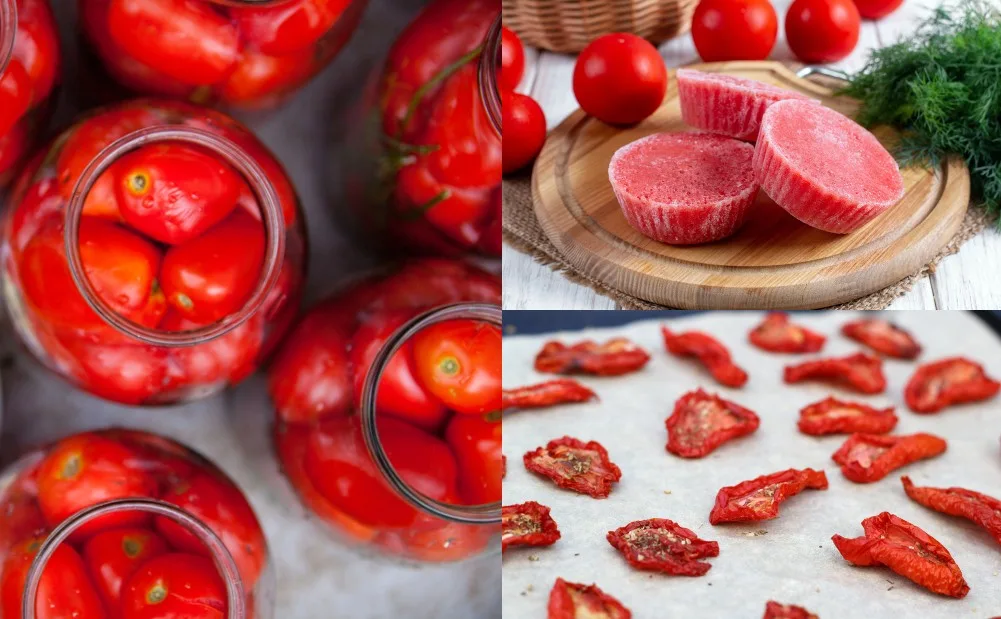
It is every gardener’s secret wish to harvest bushels of fresh, juicy, fragrant tomatoes by the bucketfuls from their over-productive garden.
In reality, at least for some of us, this is nothing more than an ambitious dream.
And yet, there are ways to make our tomato-rich visions come true. Though it helps to have a plan.
If you’ve followed our ten pro tips for high-yield tomato plants, if you’ve pruned your plants correctly, if you’ve supported your tomatoes adequately and fertilized sufficiently – and as long as you’ve avoid the most common tomato growing pitfalls – then hopefully you’ll harvest more tomatoes than you know what to do with.
If you aren’t able to grow all the tomatoes you need, you can always buy them at farmers markets, trade/exchange some of your garden crop for your neighbor’s ripest summer tomatoes, or buy them from the store.
Remember that locally grown and harvested almost always tastes the best.
Go for flavor, not for looks. After all, once they are cooked and blended into a tomato sauce, it is the flavor and texture that will stand out, not the color or the shape of the fruit.
Canning, freezing and dehydrating methods of preserving tomatoes range from simple to more complex, though none of them call for special kitchen skills. And while some of the preserving methods require more time, know that those dehydrated tomatoes are definitely worth the wait.
Gather your ripe tomatoes and let’s get preserving!
However, if it is late in the season and your tomatoes still haven’t changed color (sadly, it happens…), we have several solutions for that. Here are 20 ways to use up unripe, green tomatoes.
Canning tomatoes
It is a toss-up between canning and freezing, to find out which one is the most popular way of preserving tomatoes.
Your great-grandmother may have canned all she could to keep the pantry full, whereas your grandma might have taken more readily to using the freezer or buying tomato paste from the store.
Naturally, there are advantages to both, but since the storing of canned tomatoes uses no electricity, it receives priority here.
If you are seeking an easier route (or are not yet convinced of your water bath canning skills – your time will come!) to preserving tomatoes, skim ahead and move onto the section on freezing tomatoes.
Perhaps you can come back to canning when you have more jars, more space and more time on hand.
1. Whole peeled tomatoes
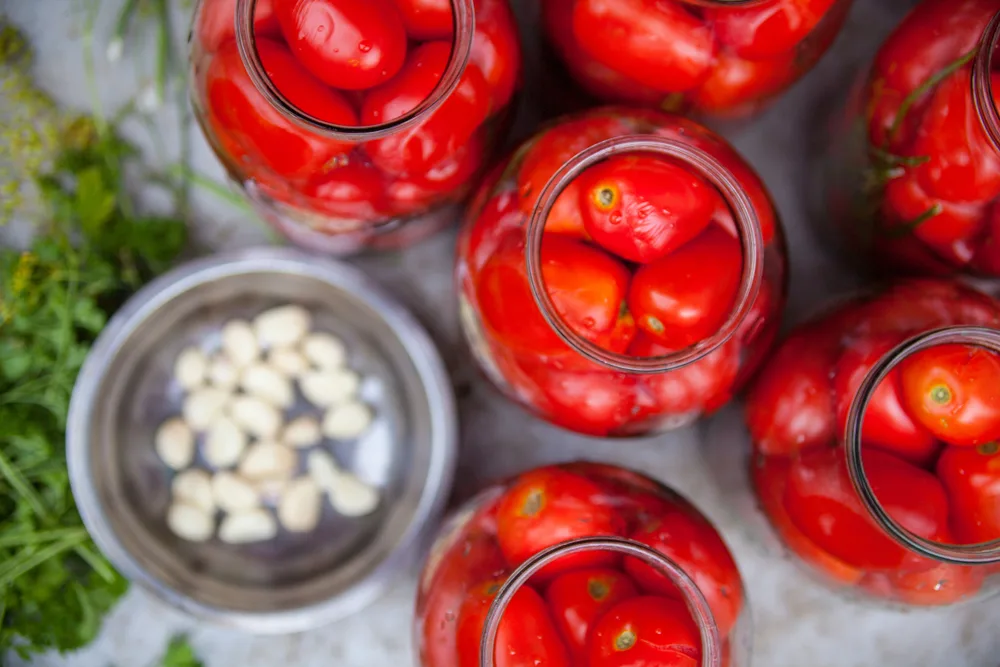
Knowing the basics of canning and preserving can take you a long way in providing healthy, wholesome food for your family.
As an organic gardener and homesteader who has been filling up our pantry for the past 15 years with chutneys, sugarless jams, pickles and dried foraged goods aplenty, I can say with good faith that the knowledge to preserve your own food is priceless.
With that in mind, you must learn how to can whole tomatoes, if you don’t know how already.
Not only do they look beautiful in jars, they can easily provide you with a yearly supply of stock for making pasta sauces and warming tomato soups.
A pressure canner or water bath canner is necessary for safely preserving tomatoes.
2. Diced tomatoes
If you like to have control over what ingredients that go in your food, or perhaps more importantly how they are stored, home canning is definitely the way to go.
Here is something to consider: because tomatoes are an acidic fruit, BPA’s in store-bought tomatoes are more likely to leach out. This makes the use of glass jars far superior.
Diced tomatoes are a wonderful thing to pull out of the pantry when you are ready to thicken a stew. Just be sure to use the very best tomatoes to begin with.
Best Tomatoes For Canning @ Practical Self Reliance
3. Tomato juice
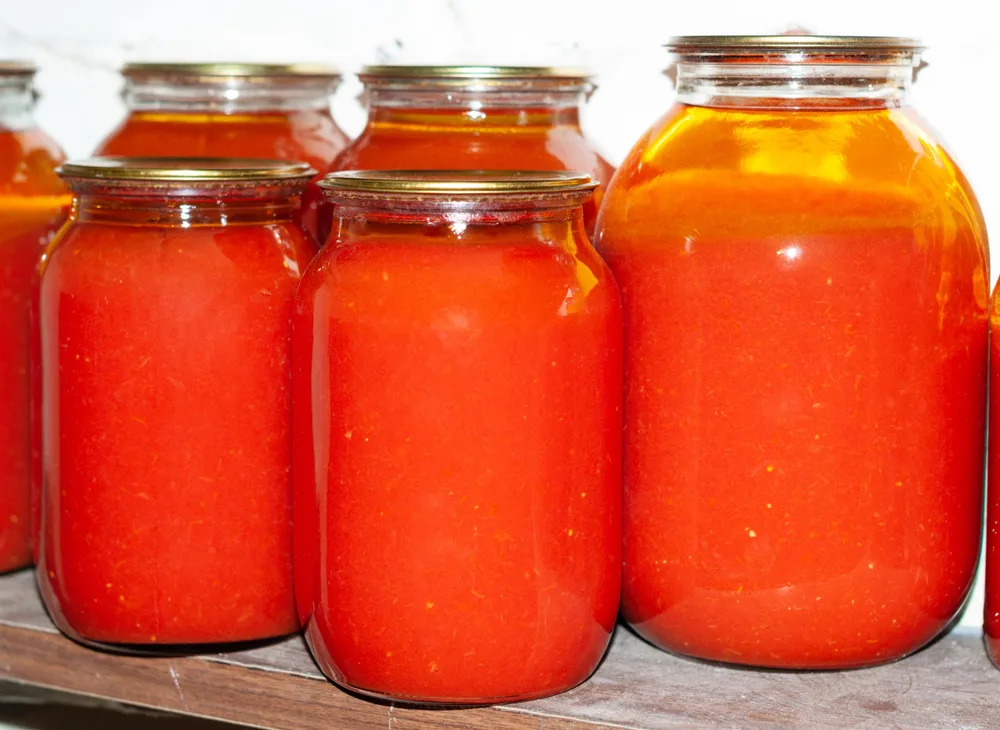
A classic pantry favorite is sure to be tomato juice. For drinking straight, as an addition to your soup, or for a well-deserved Bloody Mary.
Again, your tomato selection will greatly affect your outcome.
In the case of making tomato juice, you will want to steer clear of the meatier varieties, and grab the juicy ones instead.
Juicy tomatoes tend to be larger with thinner skins, such as Brandywine and Purple Cherokee, both heirloom tomato varieties.
How To Make and Can Tomato Juice – What To Do and What NOT To Do! @ Old World Garden Farms
4. Tomato sauce
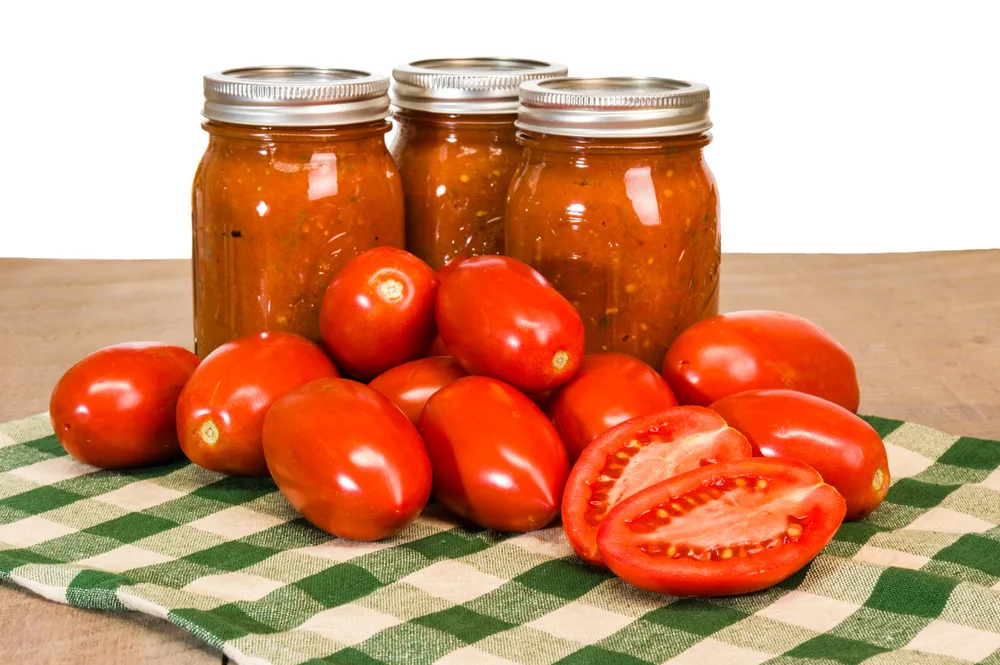
When canning tomato sauce you can go two ways. Plain and simple, as in tomato only. Or with garden spices. I believe it is best to have several jars of both, since you can add spices later if you wish, but you can’t take them away if you are seeking something plain.
And yes, plain can be a wonderful thing. It is all too easy to get carried away with spicing your homemade goods, only to find out that everything tastes like basil, or rosemary.
Store-bought tomato sauces pale in comparison to homemade, though you will have to try it to find out.
Here is one way to make seasoned tomato sauce at home.
5. Tomato paste
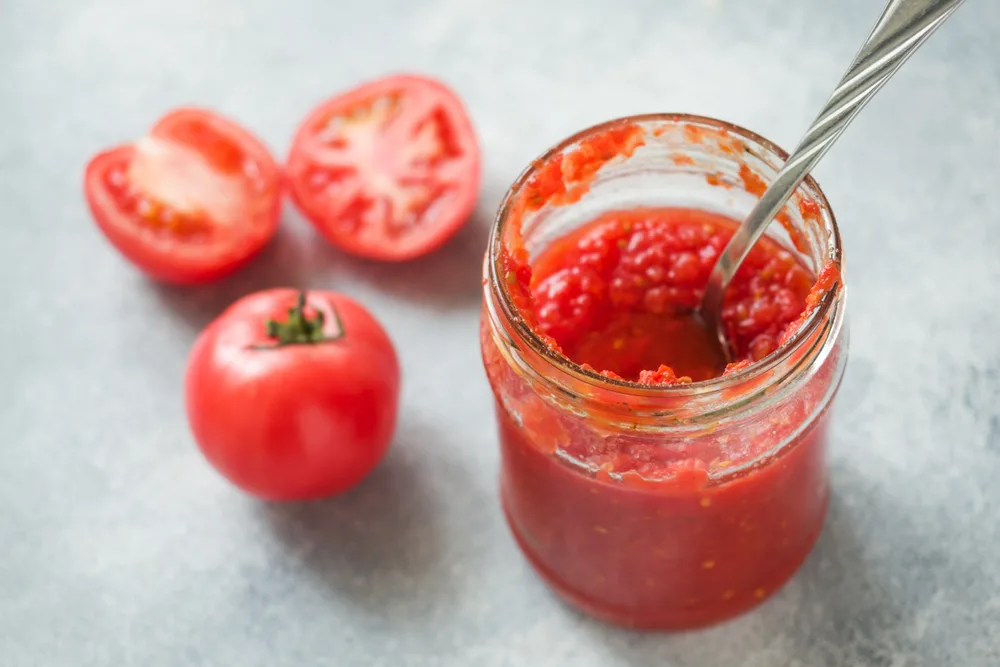
If you are keen on saving space and getting the biggest bite out of your tomatoes, tomato paste is the way to go.
When all is boiled, strained and done, you can either preserve your tomato paste by using jars in a water bath canner, or by freezing the concentrated excess.
Both ways are fabulous!
A tomato paste, is in essence, a tomato purée that has been reduced down to whatever consistency you desire.
You can evaporate this excess water by slowly heating your tomato paste over low heat on the stove, though you can also use an uncovered slow cooker.
Remember to use paste tomatoes for this purpose, those with plenty of flesh and fewer seeds. And be sure to remove the tomato seeds as well, for the thick tomato paste texture you know and love.
You can then save the seeds to regrow new tomatoes next year.
6. Tomato soup
One of the best things about having a stocked pantry is that you are fully prepared to eat, even when life throws you a curve ball.
Forget about take-away or delivery, just pop open a jar and heat the contents on the stove. Oh, so easy, and mouthwateringly delicious!
Having ready-made meals on hand seems like such a simple effort that passes by many people’s radar.
Use plenty of paste tomatoes, Romas are perfect for the job, and lots of dried herbs to come up with the best tomato soup ever.
7. Spaghetti sauce
With kids in the house, spaghetti sauce and pizza sauce are a must. It may be beneficial to have some homemade ketchup on hand too.
Adults like these tomatoey things too, after all we were once children. You can then use this spaghetti sauce to fill your lasagna and stuffed shells. Pour it over your chicken parmesan or chicken cacciatore.
For this homemade canned spaghetti sauce recipe, you will need to get out your water bath canner to process the jars in the end.
If you are thinking that a true spaghetti sauce deserves a bit of meat, put it in the freezer instead, or cook it fresh and add the canned sauce to it.
8. Pizza sauce
Same as above – this sauce is loved by kids of all ages. And if you are going to be stocking up on “comfort foods” for times of need, it is a must to stock in your cupboard for when that pizza craving hits.
The good news is that you can make your own canned pizza sauce from fresh tomatoes in the height of garden season, or with previously frozen tomatoes, as you’ll soon find out how to do below.
9. Ketchup
If you ever come into a harvest of 25-30 lbs. of tomatoes at once, you better decide what to do with them – fast.
Homemade ketchup is one way to process them quickly, in a way that everyone will look forward to eating them up.
Besides the large batch of tomatoes, you will also need to procure onions, garlic, black pepper, salt, cayenne pepper, brown cane sugar and apple cider vinegar.
Don’t forget to remove the skins and seeds once the cooked mixture is soft enough to do so. Then continue cooking over low heat until the tomato mixture is approximately 1/4 of the original volume.
Be sure to stick to the homemade ketchup recipe and follow the water bath procedure for canning.
10. Salsa
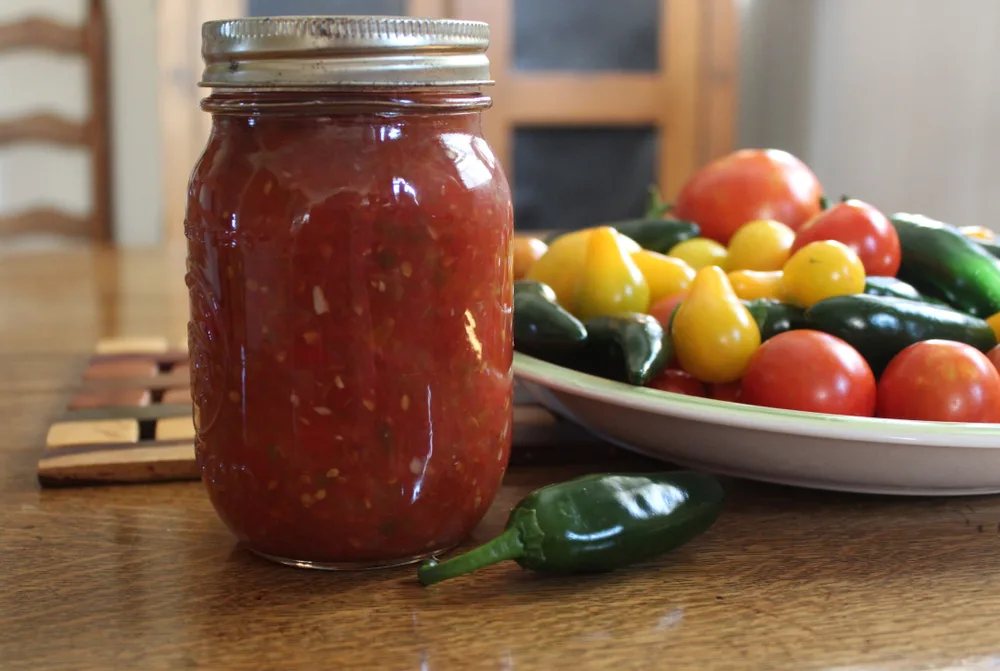
If your snacking tendencies tend to be on the spicier side, then it is salsa that is a must. And lots of it!!
There are several easy ways to can salsa, so instead of deciding on just one recipe, try a few. That way, you’ll have a choice when it comes down to dipping.
Gather your fresh tomatoes, onions, garlic, jalapeños, green chilies, cilantro, apple cider vinegar and spices – and get to work! 50 jars of salsa sounds about right, doesn’t it?!
The Best Homemade Salsa for Canning
11. Tomato chutney
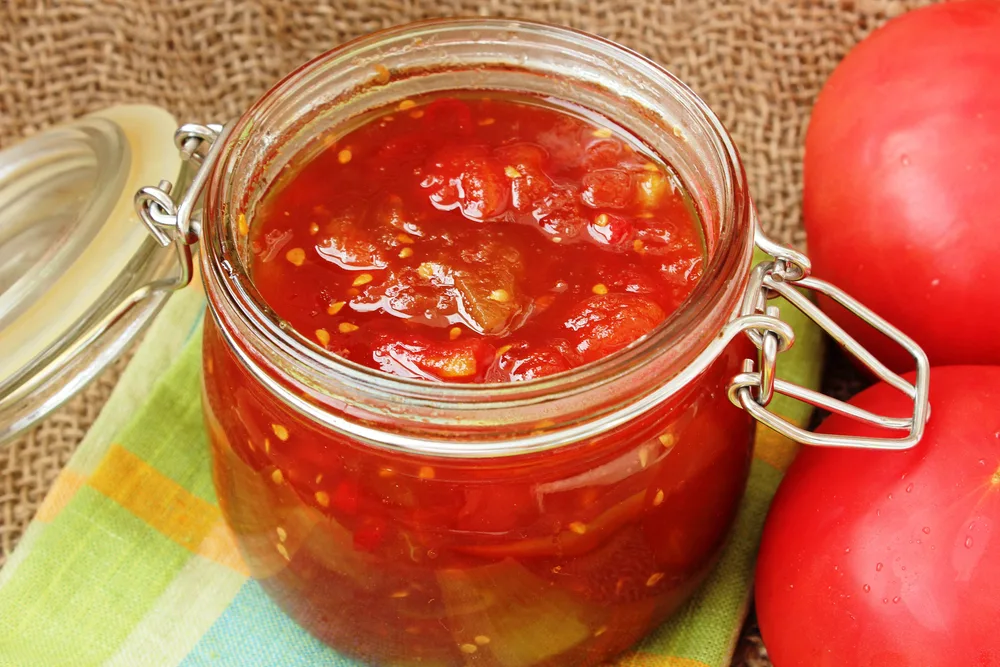
Branch out into more exotic condiments and sooner or later you will find a recipe for tomato chutney.
What makes this tomato chutney really stand apart, flavor-wise, is the added element of brown sugar, lemon zest, ground cumin and raisins. It may not sound like those flavors meld well together, but when cooked for 1.5-2 hours over low heat, trust me, they do!
With several jars of delicious tomato chutney at your disposal, you’ll have more than one reason to open up a new jar every week.
Put a spoonful of chutney on your sandwich, let it accompany grilled pork chops or a baked roast, add it to a bowl and serve it with aged cheeses and sliced sausage/meats. Or you could just sneak a spoonful straight from the jar.
12. BBQ sauce
Moving on with more condiments. One could say that they aren’t essential, but I assure you, they most certainly are.
The joy of eating is about so much more than filling your belly. It is in filling your soul with the tastiest, most scrumptious and wholesome food you can find or make. Anything above and beyond this is a bonus.
So, barbecue sauce. Love it or hate it, it is a staple in many a kitchen. It especially becomes important in summer, when grilling season starts. But what if your tomatoes aren’t producing yet? That’s where canning comes in.
If you’ve been diligent about bottling your homemade ketchup, then you can make a small batch of barbecue sauce fast.
Or you can just whip out your own jar of pre-made BBQ sauce and start marinating your meat straight away.
13. Maple BBQ sauce
If you are lucky enough to make your own maple syrup, then you will have plenty on hand to turn it into the loveliest of tangy sauces.
If you don’t necessarily want to can it, however, it can easily be frozen in individual portions, ready to pull out and defrost at a moment’s notice.
It is worth noting that a maple peach barbecue sauce can also be preserved.
14. Sweet and tangy tomato jam
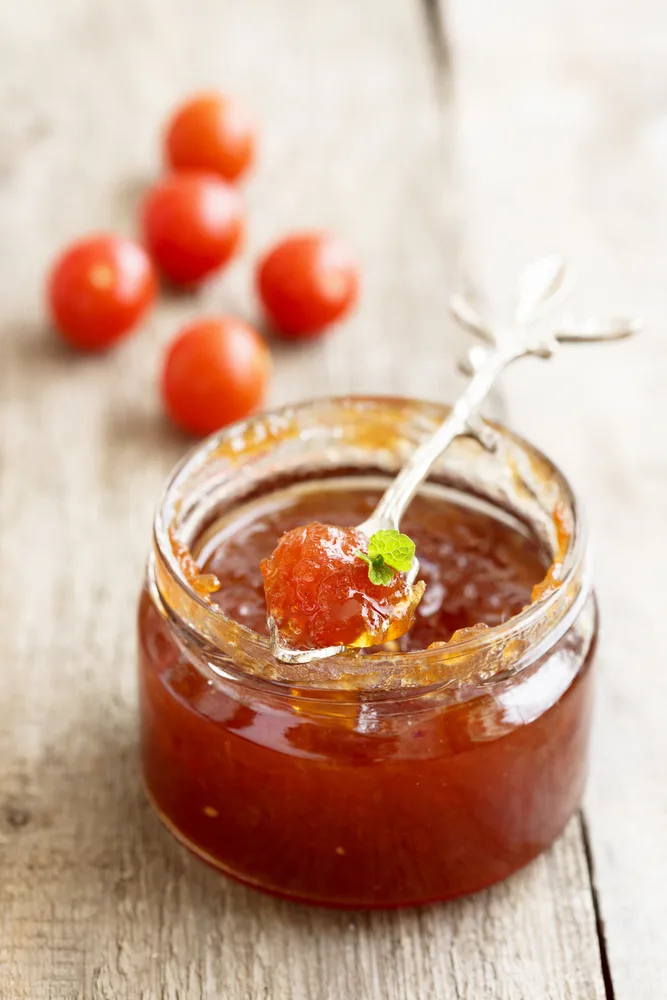
If you are seeking to bottle the essence of summer in a jar, tomato jam is where it is at.
It is a perfect and versatile topping for burgers, brats, fried fish and grilled portobellos. You’ll also find that it suits cheese and crackers nicely, and makes for a terrific picnic food.
Be sure to make some for yourself, and enough for gifts too!
Find the best recipe here:
Summer Tomato Jam @ Healthy Delicious
15. Pickled cherry tomatoes
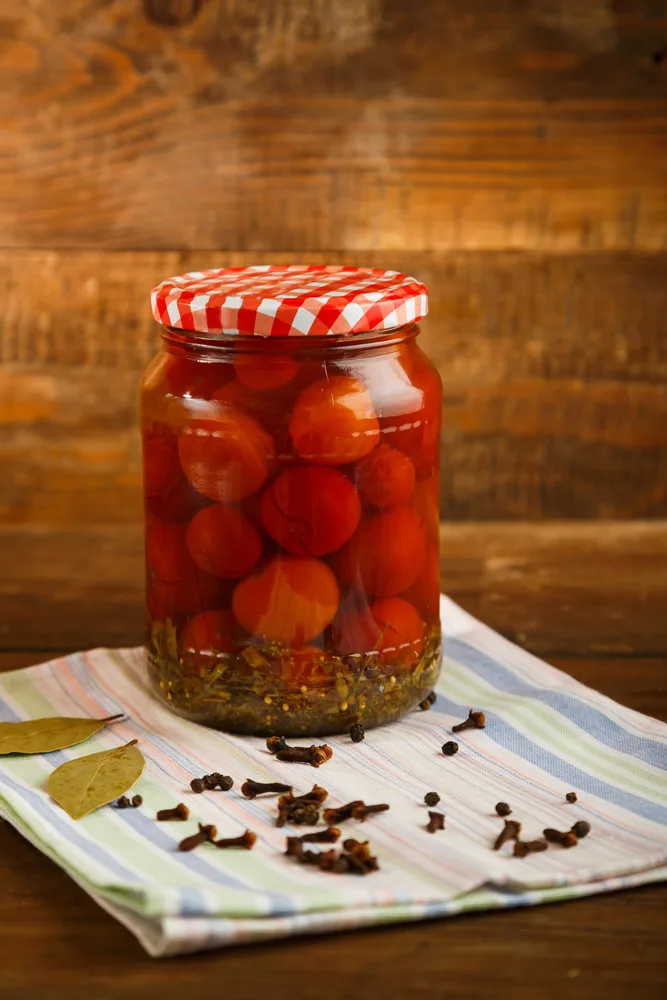
What will you do with a bounty of cherry tomatoes? It seems like such a shame to put them in a sauce, losing their shape and beautiful range of colors. Dehydrating is often the preferred method for preserving cherry tomatoes, though pickling also gives them the justice they deserve.
Learn how to pickle cherry tomatoes for either short-term (two months in the fridge) or long-term pantry storage.
Open up a small jar anytime you are in need of dressing up a salad, or for your after-gardening martini.
Freezing tomatoes
The simplest way of preserving tomatoes is to freeze them.
Blanch them, or not.
Chop them into pieces, cut them half, or not.
Vacuum seal them, or not.
You don’t need any special canning equipment for freezing, in fact you may not need anything at all (outside of a vessel for storing them in).
If you are low on time and rich in tomatoes, it makes perfect sense to freeze them if you have plenty of space in the freezer. Though in the storing of any foodstuff, diversity is best, so mix up your frozen tomatoes with canned and dehydrated ones, if you are able to.
15. Whole tomatoes
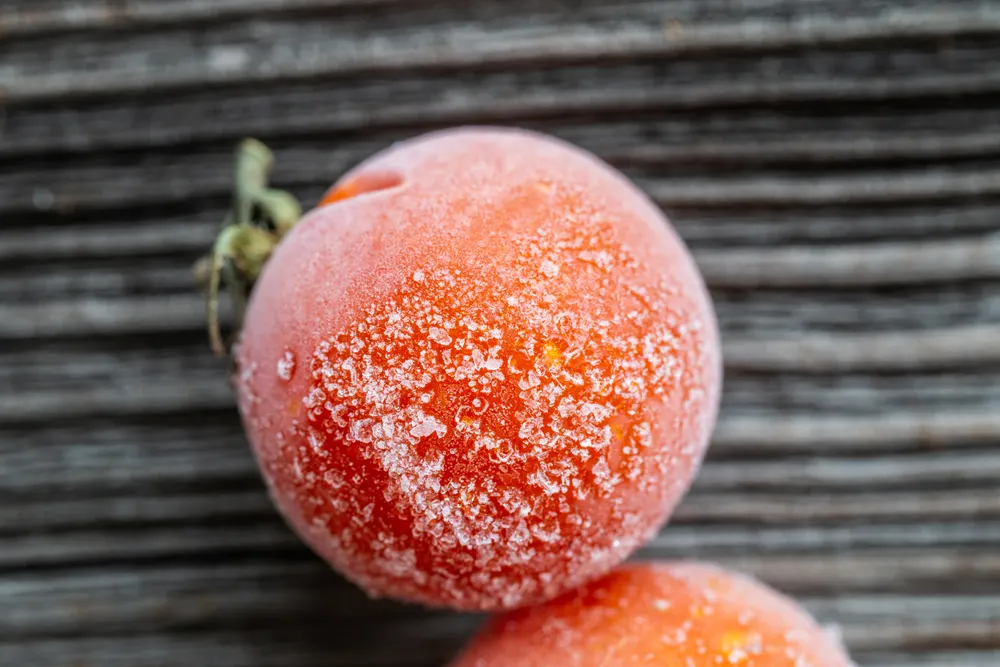
When it becomes too difficult to keep up with canning and dehydrating your bountiful summer harvest, take a cool break with a glass of switchel. Then get back to your tomatoes.
There are a few ways to go about freezing your crop of tomatoes. Some people take the extra step to blanch and cut them into smaller pieces. Others freeze them whole with skins on. It all depends on just how much space you have to dedicate to tomatoes in your freezer.
16. Cherry tomatoes
Once your cherry tomatoes are harvested, washed and dried, you can then lay them in a single layer on a baking sheet and place them immediately in the freezer.
Since they are so small, they will freeze sufficiently in 1-2 hours. After that, you can place the frozen “cherries” into a container or freezer bag for longer storage. Use them in soups and stews, adding them iced as they are.
To give them more exciting flavor, you also have the option of cutting them in half, sprinkling with your favorite spices and roasting them before freezing.
17. Tomato puree and sauce
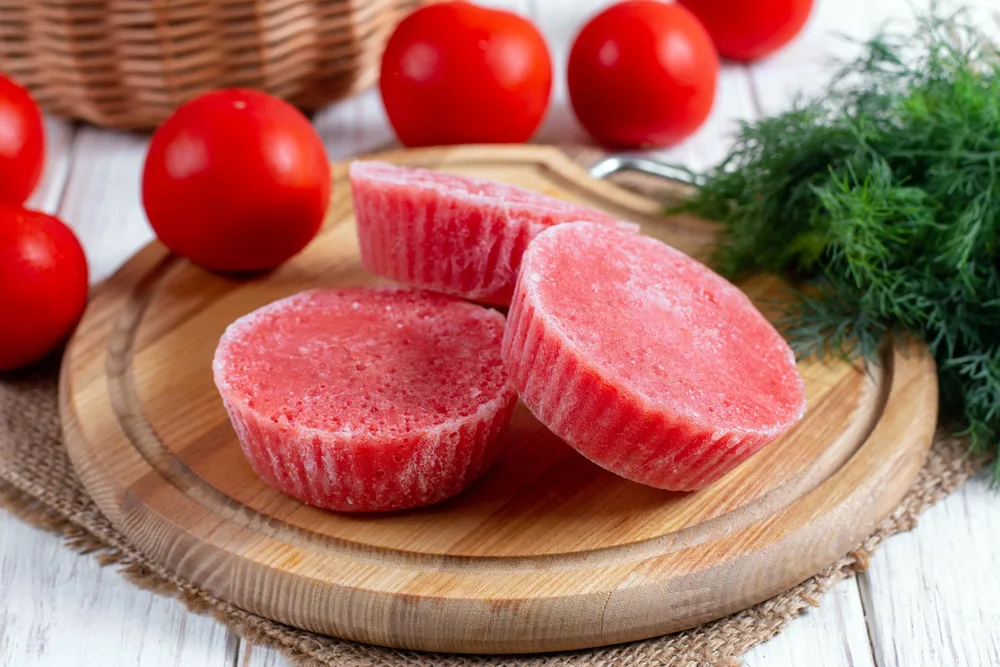
Now, that you know how to make all sorts of sauces from your tomatoes, you can store them in the freezer instead of using a water bath canner.
Most commonly, people will reach for a freezer bag to contain the food, though that is not the only option.
Sauces, for instance, are easy to store in glass jars. Not only is this a way to help you reduce your plastic consumption, it is a clever zero-waste hack for reusing the jars you already own.
Here are the in’s and out’s on how to work it out, without breaking any jars in the process:
How to Freeze Food in Glass Jars – Without Plastic @ Smarticular
18. Freezer pizza sauce
You can take any of your favorite pizza sauce recipes and freeze them in individual or family-size portions for later. This helps immensely with meal planning, quick-to-fix snacks and requests for going out – when all you want to do is stay in.
Don’t forget that many of the options for canning tomatoes are also good for freezing. Just keep in mind how the end product will be eaten. For example, frozen and thawed salsa becomes watery after defrosting and a little less desirable.
If you stick to freezing tomatoes that will be cooked again afterwards, say to thicken chili, then you are on the right track.
Dehydrating tomatoes
Among the most flavorful ways of preserving tomatoes is dehydrating.
Cherry tomatoes work best for this as they dry out quickly when halved – the question is, do you have enough heat from the sun to make it happen?
Or will you rely on your dehydrator or oven to do the work?
19. Sun-dried tomatoes
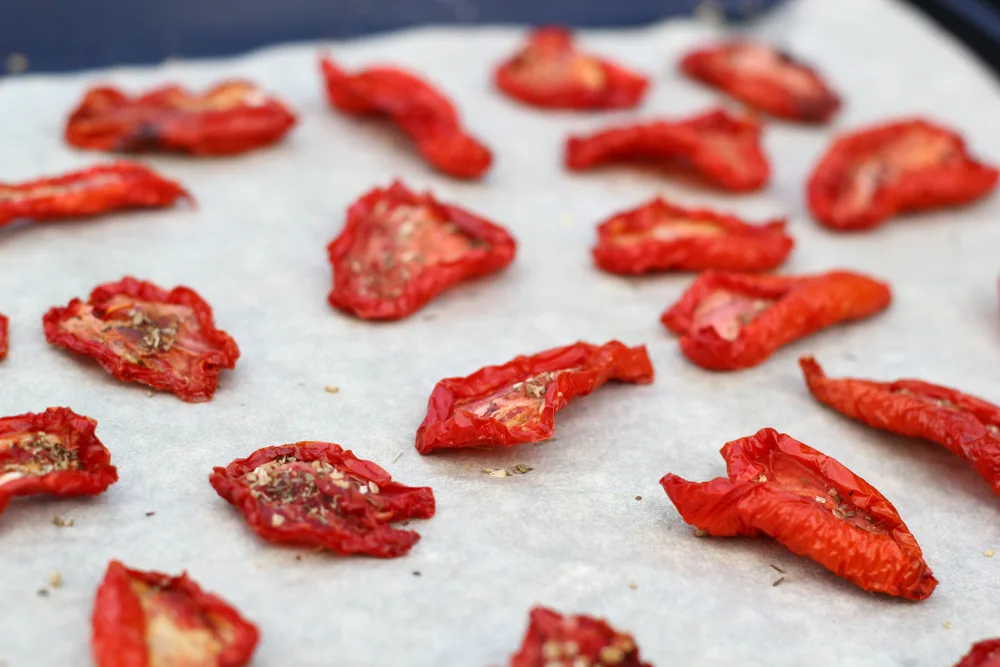
In your search for how to make sun-dried tomatoes, chances are great that you will first come upon a recipe of how to make oven “sun-dried” tomatoes.
This is all well and good, for those times when the sun refuses to shine in combination and with perfect timing of your bountiful harvest of tomatoes – that need to be dealt with right now!
If you do have sufficient sun, however, it is worth any and all extra effort to dry them using solar energy. The old-fashioned way of drying tomatoes on a screen definitely has its advantages.
True sun-dried tomatoes are not only more flavorful than those from the dehydrator or oven, they use zero energy, making a perfect way of preserving if you just happen to live off-grid.
Don’t forget about preserving sun-dried tomatoes in olive oil too!
20. Tomato chips
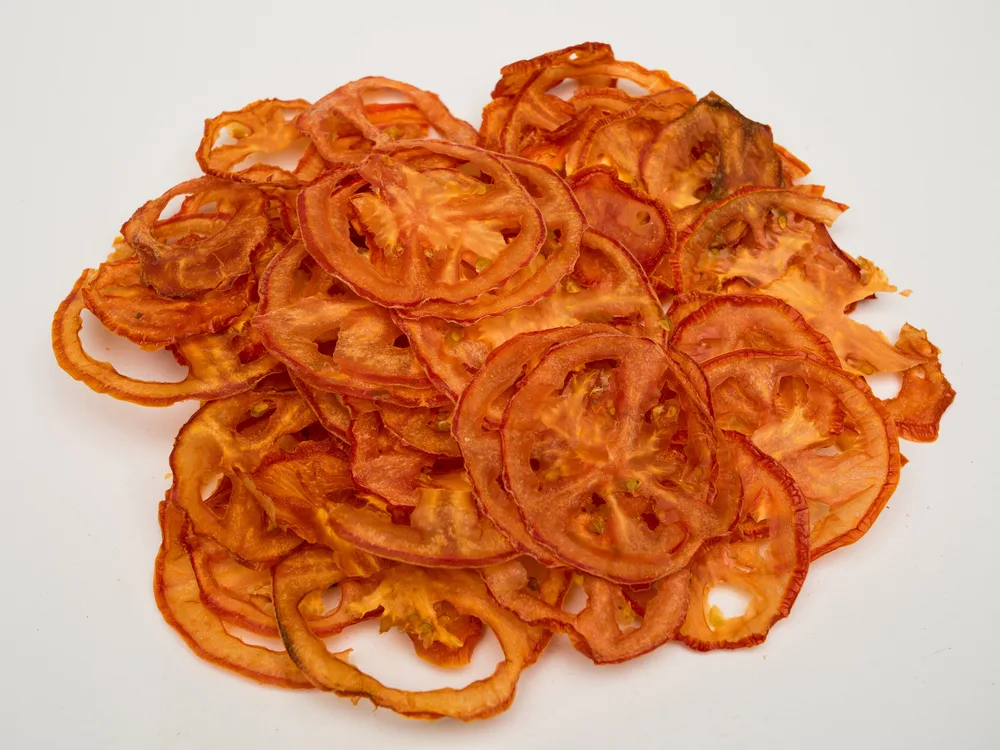
Whether or not the sun shines, is up to Mother Nature herself. But the amount of sunlight hours is not enough for sun-drying. The temperatures have to be high enough too.
Enter the modern food dehydrator.
It eliminates the waiting and wondering of when the clouds are going to float away. Giving you more time to prepare your tomatoes in interesting ways for drying and storing.
If you have never tried tomato chips before, make this the year you do, for healthy snacks throughout the year.
21. Tomato powder
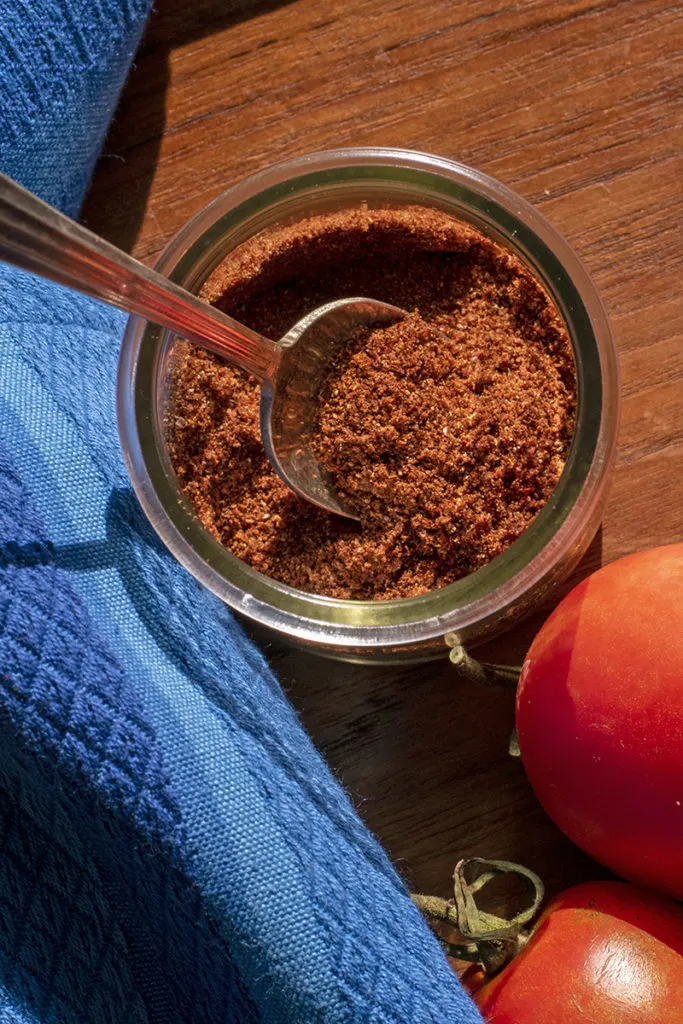
In an effort to stock your pantry with a variety of homemade goodies, you need to look at all the possibilities.
What happens when both your freezer and canning shelves are full? Turn to powders of all sorts.
Garlic powder, onion powder, nettle powder, hop shoot powder and tomato powder, just to name a few.
As an added bonus – once your vegetables and/or wild herbs are dehydrated and ground, they take up little space in the kitchen.
With tomato powder, a little flavor goes a long way: add a small spoonful to your soup, enchilada sauce, sprinkled over potato wedges or over salads for enriching the flavor and quality of just about everything you eat.
Take a look at our DIY tutorial for making tomato powder here.
22. Tomato sauce leather
You don’t need to be a prepper or a backpacker to enjoy tomato sauce leather, though it doesn’t hurt to embrace it for what it is.
Tomato sauce leather looks like any other fruit leather, though it tastes completely different. A bit sour and definitely not snack-worthy on its own, though it does have merits.
When made properly, you can then add a strip to your pasta or rice meals for a quick and easy flavor, sprinkling as many spices to the tomato leather as you like.
Fermenting tomatoes
If you aren’t seeking long-term storage of your entire surplus of tomatoes, fermenting is another tasty way to extend your tomato harvest.
Lacto-fermenting takes your tomatoes to another flavor profile that may be new to you, though I encourage you to experiment with it, for all ferments are supporting your gut-health. So, they are beneficial in different ways than what standard storage provides.
This must-read book will show you how to ferment just about anything that grows in your garden, tomato cherry bombs included:
23. Lacto-fermented salsa
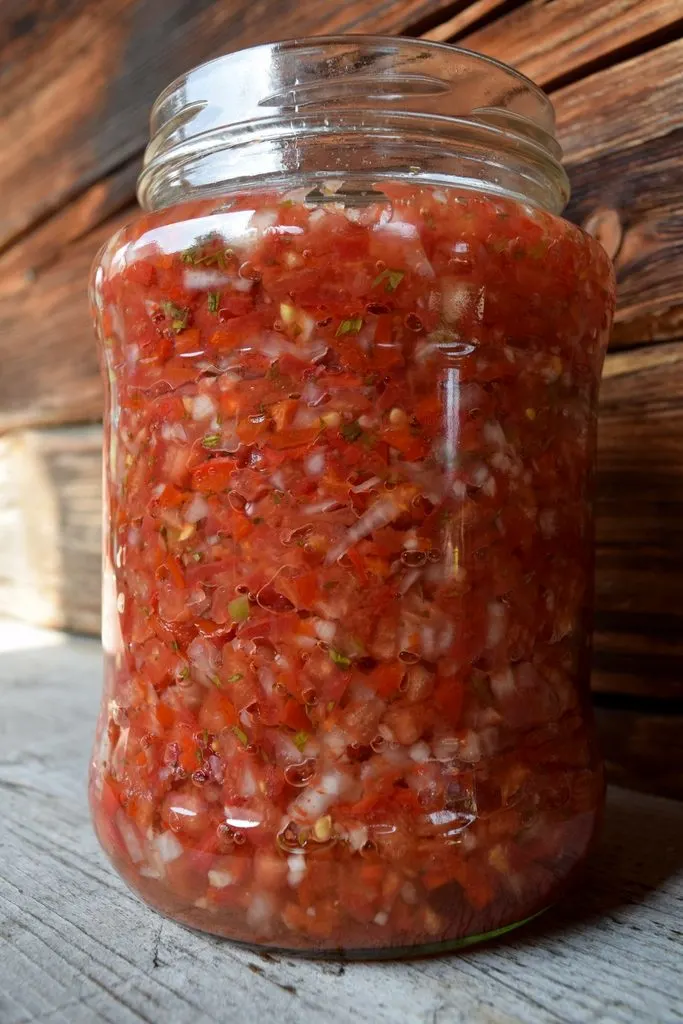
Even more than fresh, or canned, homemade salsa, our family ultimately prefers wild fermented salsa. It is garlicky, spicy, rich in tomatoes and bursting with flavor.
Try it. Love it. And then share it with others.
Some people may think that eating fermented foods takes an acquired taste, and that may just be true.
Learning to eat outside of brand names can take some time, though it gives you plenty of appreciation for what you can grow in your own garden. Fermenting is simpler than you think. Pick a few easy recipes and try it!
24. Fermented cherry tomato bombs
What to do with all those cherry tomatoes, other than freezing, dehydrating and making sauces? Ferment them.
If you are looking to increase your self-reliant kitchen skills, try this fail-proof recipe of fermented cherry tomato bombs and see what happens.
The end result is effervescent little “cherries” that have a subtle bite. Perfect for a surprise element in salads or tucked away in sandwiches. Store them for up to 6 months in the fridge.
It is a wonderful way to get children to try fermented foods, along with fermented ketchup, of course.
25. Green tomato olives
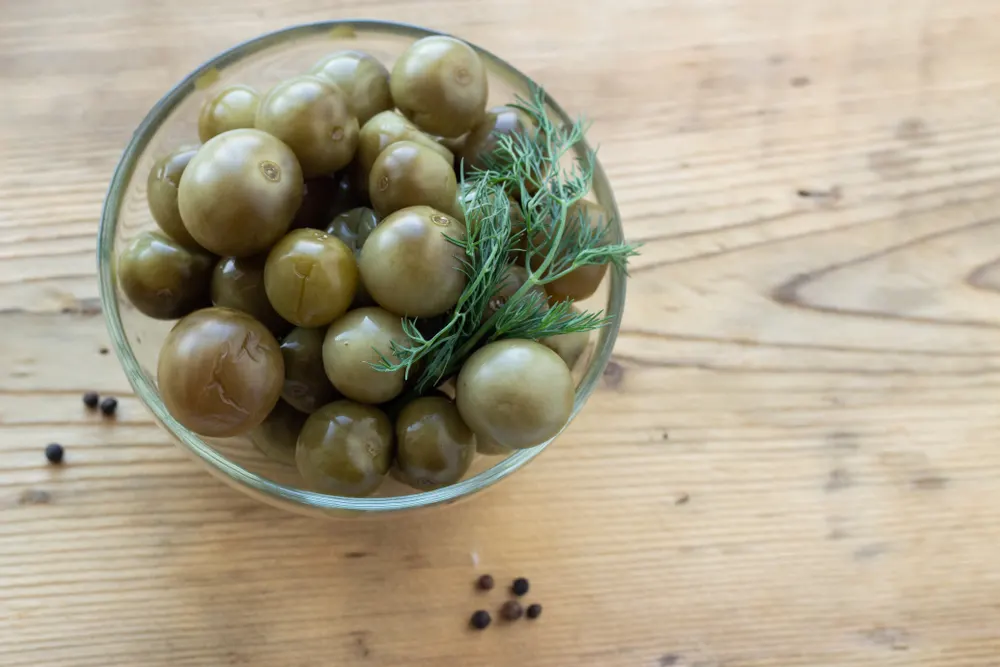
In the realm of fermenting, you’ll discover all sorts of interesting ways to preserve food, stuff you may not have thought about on your own.
Lacto-fermented green tomato olives definitely fit in here. They are slightly bitter and ever so salty with a juicy (not mushy) bite.
Use them in cocktails, toss them in salads, add them to your homemade pizza – your imagination is the limit.
26. Fermented ketchup
Canned ketchup is one thing, fermented ketchup is quite another. One thing they have in common is that you are in control of the ingredients.
It is your choice to omit the high-fructose corn syrup in search of better health, it is your right to refuse overly processed vinegar, accepting only vinegar with the mother instead.
Vinegar is an essential ingredient of commercially prepared ketchup, though you’ll find a mere 2 tablespoons of raw apple cider vinegar in lacto-fermented ketchup.
One of the best parts of fermented ketchup, besides the superior taste, is that it can be made from your own homemade canned tomato paste, so you can make a small batch as often as it is demanded.
Final thoughts on preserving tomatoes and canning in general
When you have the time to sit down and think about it, observe how many store-bought items you could possibly make at home.
Make a list of the items you buy the most, and figure out how to replace them, one at a time, with a homemade alternative. There may be some small disasters along the way, yet practice makes perfect.
And if you never try, you will never know whether or not you are capable of creating such delicious, home-canned masterpieces.
Gather canning knowledge from workshops, from videos and reading books. Most of all, just try it, every chance you get. You have nothing to lose, and all the jars of tomato sauce, tomato juice and tomato soup to gain.
If you are new to canning, find many excellent tried, tested and true recipes here:

Get the famous Rural Sprout newsletter delivered to your inbox.
Including Sunday musings from our editor, Tracey, as well as “What’s Up Wednesday” our roundup of what’s in season and new article updates and alerts.


